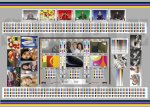Elton McAleer
Member
Hello PrintPlaneteers,
I work for Frontline Technologies in New Zealand. We are a supplier of pre-press solutions, proofing, colour management plates, setters etc. I have a background in colour management from 'both sides of the fence' having trained in CMYK repro and also spent several years in the 'RGB world' as Digital Production Manager with Getty Images inc in London.
I am a Fogra Certified partner for the implementation of PSO (process standard offset), and have been impressed at the uptake of ISO 12647-2 standards in the market - although I have found that most customers are happy to 'comply' to the standards without actually taking the Fogra/Bvdm PSO tests for certification.
My question is regarding The new ISO standard for NP screening, PSO_Coated_NPscreen_ISO12647_eci, based on the Fogra 43 dataset, and it's suitability (or not) as a target for a Kodak Staccato workflow.
I have achieved a great AM 150/175 lpi result, using Harmony to hit the ISO Coated V2 target gains. These are stated as Curves A (CMY TVI = 13% @ 40) and B (K TVI = 16% @ 40).
The ISO target for NP screening stipulates Curve F - CMYK TVI = 28% @ 40.
So - should I use ISOCoatedV2 TVI aim values or ISO NP Curve F values when printing with Staccato screening (on a magnus/sword ultra/ 20 or 25 micron)?
I would be interested to hear if any other stacatto users have attempted to match the new ISO NP target. The results I got with staccato are very heavy and flat when using (and hitting on press) a 28% tvi @ 40 as the aim value...
Upon measuring linear plates with an IC plate II advanced, AM 150/175# is producing a pretty perfect result - ie max deviation <1 (eg 40=39.5, 60=60.2 etc). A staccato version of the same produces slightly more deviation up to approx 2.5% difference between target/measured (eg 70=67.5, 85=87 etc)
Should I use a separate harmony plate curve to correct to linear before applying a press compensation curve, or will a second curve just cause smoothness problems?
My customers objective is to produce a 'visual match with the improved detail and gamut' (ie not really a match!) that they expect from staccato.
Any thoughts readers have on this subject would be greatly appreciated.....
I look forward to being an active member of this group!
Best regards,
Elton McAleer
I work for Frontline Technologies in New Zealand. We are a supplier of pre-press solutions, proofing, colour management plates, setters etc. I have a background in colour management from 'both sides of the fence' having trained in CMYK repro and also spent several years in the 'RGB world' as Digital Production Manager with Getty Images inc in London.
I am a Fogra Certified partner for the implementation of PSO (process standard offset), and have been impressed at the uptake of ISO 12647-2 standards in the market - although I have found that most customers are happy to 'comply' to the standards without actually taking the Fogra/Bvdm PSO tests for certification.
My question is regarding The new ISO standard for NP screening, PSO_Coated_NPscreen_ISO12647_eci, based on the Fogra 43 dataset, and it's suitability (or not) as a target for a Kodak Staccato workflow.
I have achieved a great AM 150/175 lpi result, using Harmony to hit the ISO Coated V2 target gains. These are stated as Curves A (CMY TVI = 13% @ 40) and B (K TVI = 16% @ 40).
The ISO target for NP screening stipulates Curve F - CMYK TVI = 28% @ 40.
So - should I use ISOCoatedV2 TVI aim values or ISO NP Curve F values when printing with Staccato screening (on a magnus/sword ultra/ 20 or 25 micron)?
I would be interested to hear if any other stacatto users have attempted to match the new ISO NP target. The results I got with staccato are very heavy and flat when using (and hitting on press) a 28% tvi @ 40 as the aim value...
Upon measuring linear plates with an IC plate II advanced, AM 150/175# is producing a pretty perfect result - ie max deviation <1 (eg 40=39.5, 60=60.2 etc). A staccato version of the same produces slightly more deviation up to approx 2.5% difference between target/measured (eg 70=67.5, 85=87 etc)
Should I use a separate harmony plate curve to correct to linear before applying a press compensation curve, or will a second curve just cause smoothness problems?
My customers objective is to produce a 'visual match with the improved detail and gamut' (ie not really a match!) that they expect from staccato.
Any thoughts readers have on this subject would be greatly appreciated.....
I look forward to being an active member of this group!
Best regards,
Elton McAleer















